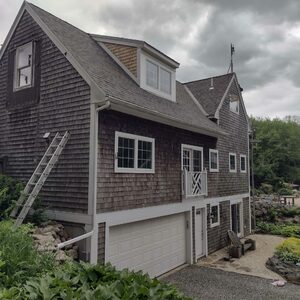I will be running most of the power and datacom wiring in conduit for an ICF house with SIP roof I am building for myself. The site is close enough the Pacific Coast that corrosion is a constant issue. Originally I planned to run mostly EMT conduit but am having second thoughts. I will still use steel boxes even if I went with the PVC conduit. Access is almost unrestricted from the workshop below, through the ceiling/deck, to the living area above – same with plumbing.
Either material is so inexpensive that cost is not a factor. I will run the above ground conduits myself. I would probably get a hot box for bending PVC if I go with ENT. I have run a lot of EMT and rigid tubing. Any thoughts as to the best way to go would be appreciated.



















Replies
I can't answer questions about code or electrical shielding. But, I do have experience with wiring in corrosive environments. I worked for many years in a manufacturing plant in which one department had acid vapors (less than 5 ppm). In that environment no steel conduit would be unaffected. It would be rare for EMT to corrode to the point of failing to provide physical protection of the wires. Rigid conduit corroded badly on the ouside, but never fell apart. We ran PVC mostly for appearance sake, and also because opening and closing boxes, LB's, and so forth was much easier. However, unless the boxes and electrical panels were sealed and gasketed and provided with either dry purge air or corrosion absorbing substances, like Z-Rust capsules, the wiring, shielding, boards, terminal strips, and so forth corroded anyway, regardless of the conduit used. The insulation on the wires was unharmed.
This environment is much worse than you'd ever find in a home, even by the ocean. Every metallic surface showed visible corrosion in a couple of weeks, even stainless steel.
I think you can go with anything you want in your case. Since PVC is cheap and easy to work with, it would not be a bad choice. But, if you are going to have corrosion, you'll have much worse problems with the working parts of your system than you would ever have with the conduit.
Cjd: Isn't there a prohibition in code about using PVC conduit in inhabited spaces? I went through the same set of issues w/ my ICF house. I stuck one piece of PVC conduit in that was about 3 ft long, and prevailed on my county inspector for a waiver, which he gave me.
Don
Wiring method approval varies by local code, not NEC. Here in Virginia PVC conduit is approved for inhabited residential applications. I use it a lot for telephone, cable, CAT-5 and some for AC wiring.
Frank DuVal
"I would probably get a hot box for bending PVC if I go with ENT."
PVC conduit is not the same as ENT.
ENT is a flexible plastic conduit, AKA surf tubing. It is free bending.
http://www.carlon.com/sd-cgi/hsrun.hse/CarlonCatalog/ProductCatalog/ProductCatalog.hjx;flag=restart;start=ProductCatalog.HsLogin.run?FromSite=carlon&CatalogObjectId=70
And why would you want to use steel boxes if you went with PVC conduit?
And why would you want to use steel boxes if you went with PVC conduit?
Hi Bill. Unsure of what CJD's doing but I found plastic boxes didn't stay anywhere near square after I dumped concrete on them and tickled the mud. Somewhere in there, they deformed substantially. Steel boxes worked much better for placement inside concrete. I'm using bolts through the mounting tabs to position them.
Thanks for the Carlon link. Something new to me. I'm pretty sure I'll stick with pvc conduit mostly, for rigidity. Little worse than finding out the conduit/boxes you placed inside a wall isn't where you left it after you strip the forms.
PAHS Designer/Builder- Bury it!
I don't know what kind of system that he is using, but I thought that with ICF the boxes would not be in the concrete. Nor the conduit except maybe to pass from exterior to interior.
ENT stands for Electrical Nonmetallic Tubing. It can be rigid or flexible, and made from several plastics including PVC and fiberglass. PVC can also be called RNT for Rigid Nonmetallic Tubing, but I have never seen that term outside of a code book. Most commonly ENT refers to rigid light gray schedule 40 and 80 PVC in my area, though I should have been more specific.
Rigid PVC ENT conduit is commonly left exposed in commercial and uninhabited spaces in California. The plan is to have the majority of electrical conduit and plumbing exposed on the roof of the shop which will penetrate the ceiling and enter the space above. Plumbing will enter in front of the wall and be hidden by cabinets and the electrical will center in the interior walls.
Conduit and pipe are seldom imbedded in concrete in ICF construction. The vast majority is installed in the 2 to 2¾" thick EPS/rigid insulation after the pour.
I will to use steel boxes for switch, receptacle, and junction boxes because they will be imbedded in the EPS and below the drywall where they will not be exposed to nearly as much the salt-air corrosion. Steel boxes with a mud ring are inexpensive compared to plastic conduit box products and hold up to more abuse from drywaller's Rotozips and years of cover plate removal for painting and repair.
WAYNEL5: That sounds like a difficult environment. What did you have to do to protect yourself while working in it?
Edited 3/19/2004 10:39 am ET by CJD
To answer your question, it wasn't really hazardous to us. The material was hydrogen chloride, which, when exposed to moisture forms hydrochloric acid. Hydrochloric acid is stomach acid and is not harmful at low concentrations. The machines that produced the vapors were in isolated rooms which were only entered for one or two minutes each hour to check on them. The concentration in the rooms was less than the OSHA limit, which if I remember correctly was 5 ppm, so we could have worked in the rooms all day and not been exposed to a harmful amount. But, the equipment, of course, was exposed 24/7.
Outside the rooms the concentration was very much lower, well below 1 ppm, but it was enough to attack nearly any metal in only a few weeks. Employee work areas were not in either area. I saw no corrosion were employees worked.
"To answer your question, it wasn't really hazardous to us. The material was hydrogen chloride, which, when exposed to moisture forms hydrochloric acid. Hydrochloric acid is stomach acid and is not harmful at low concentrations. The machines that produced the vapors were in isolated rooms which were only entered for one or two minutes each hour to check on them. The concentration in the rooms was less than the OSHA limit, which if I remember correctly was 5 ppm, so we could have worked in the rooms all day and not been exposed to a harmful amount. But, the equipment, of course, was exposed 24/7."
Yup. I'm an electrical engineer, and most of my work is in the design of municipal water treatment plants. Most of them use chlorine and/or fluoride (in the form of fluorosilicic acid) as part of the treatment process, and we use nothing but PVC conduit in the chemical rooms since metallic conduit rusts in no time flat from the vapors in the air.
Re: "RNT for Rigid Nonmetallic Tubing"
Interesting. I'm not familiar with this stuff. Could you provide an article number in the 2002 NEC dealing with this material? I'd like to read more about it.
"Re: "RNT for Rigid Nonmetallic Tubing"
Interesting. I'm not familiar with this stuff. Could you provide an article number in the 2002 NEC dealing with this material? I'd like to read more about it."
My 2002 copy of the NEC is at work so I can't be 100% sure, but according to the 1999 NEC I have here at home it's article 347.
RNT is referred to along with all the other conduit and wire acronyms on page 453, table E3701.2, ALLOWABLE WIRING METHODS, in the 2000 International Residential Code. It doesn't say much more about it than that. I don’t have a copy of the NEC here and can't swear that I have seen RNT in it.
ENT is what every supplier from Graybar Electric (west coast wholesaler) to Home Depot calls PVC conduit around here. ENT appears to be used for any rigid or flexible plastic conduit in some areas, which makes sense. I doubt that RNT will ever be widely used since ENT is part such a part of the trade lexicon. In reality, most people I work with just call it PVC.
Hi CJD,
Maybe we all need to get on the same page as far as terminology.If you were to look in the 2002 NEC you'll find that the light gray Schedule 40 and 80 PVC pipe that we all use is officially identified in Article 352 as Rigid Nonmetallic Conduit:Type RNC.The corrugated blue smurf tube that 4Lorn1 so correctly bashes is in Article 362 Electrical Nonmetallic Tubing :Type ENT. There is also a Liquidtight Flexible Nonmetallic Conduit Type LFNC(Art.356),it's like "sealtite" with no metallic core that we use to connect to motors, for example, in corrosive environments.
I agree with 4Lorn1 that for your purposes ENT that will be exposed on your workshop ceiling would look bad.Hack contractors want to use it everywhere but it really results in a crappy mechanical job.I used it to wire a log cabin once and it was a PITA to keep from breaking and pulling out of the connectors.
What you're talking about using,PVC conduit,would look much better exposed.In small sizes though putting it in a heater makes it pretty wavy gravy.It doesn't matter in a ditch or pour,but on your workshop ceiling you'll want to be more careful.I'd use as much planned right angle routing with boxes and LB's as possible.When you do have to heat it,measure the bend just like with EMT,lay the hot PVC on a FLAT floor and cool it with a wet rag while measuring with your rule.
EMT would be the exposed standard where I work,but if you're too close to the salt air that would be out.I wish I did have to worry about salt air.
Whichever you use pay attention to your fastener material.Sometimes you can see an exterior EMT installation that's a year old and looks good except for the screws that are fastening the one hole straps.Rust stains on white split face block really look terrible.
Barry
I thought that with ICF the boxes would not be in the concrete. Nor the conduit except maybe to pass from exterior to interior.
Absolutely, as he explained.
I have little use for ICFs as they're thermally inferior to a cast wall with exterior insulation, if you remember Cloud's previous thread. Would be a very large mistake with PAHS.PAHS Designer/Builder- Bury it!
ENT is commonly referred to around these parts, Florida, as 'smurf tube' because of its typical blue color. Usually preceded by 'I wouldn't wire a doghouse', or, 'my worse enemies house', with smurf tube. This material is associated with the cheapest, flimsiest and least durable of all construction methods.
Most electricians with some experience with service work have seen their share of sloppy, shabby and broken down ENT installations. I do not rate it highly. Too often I have seen the material become brittle in the heat leaving the conductors exposed. Even when the ENT is intact the physical protection provided by it is minimal.
The fittings used with this system are also, IMHO, weak and poorly designed. Even more so than the ENT conduit itself. Often I have seen connectors which have fallen out of boxes as they aged and couplings that let go of the lengths of ENT in time. Sometimes this causes shorts when a connector fails and allows the wires to rub against the edge of the KO in a metallic box.
Some of this comes from the general impression that most ENT installations seem designed to be the absolute legal minimum. Too often it seems to be designed to last only long enough for the ink to dry on the inspection slip.
PVC conduit, armor flex, nonmetallic flexible conduit or EMT are by far the better, more durable and long lasting raceway systems. Some of these are not very much more expensive than ENT.
ENT does has some uses. With care I have seen it, never done it myself as I try to talk them into going with PVC, poured into concrete. As long as the connectors and couplings hold the cement reinforces the ENT and the wires are pulled in and remain safe.
The one use I have made of ENT is using it as a chase system for communications, stereo systems and networking. It can be snaked in and cables pulled in and out. Run in one piece, without connectors or couplings to fail, from the open wall cavity to attic or crawl space where it meets, but is not connected with a 2" PVC main run.
I routinely use PVC conduit when wiring underground septic pumping stations. I have had very good results with this in a wet and somewhat corrosive environment. These pumping stations are cast concrete tanks about 8x8x5 feet and are the initial receiving tanks for gravity fed waste. From there, an electric trash pump is used to push the slops uphill to the actual septic tank in situations where natural grade does not allow a gravity feed directly to it from the house.
The conduit is run underground in a shallow trench alongside the waste line, and enters the pumping station through a hole bored in the side of the tank just below the lid. Inside, we mount a PVC 4" round and make all connections for the pump power, float switch leg, and high-level alarm sensor inside that box. I use waterproof compression fittings for all wiring exiting the box. All joints in the conduit are solvent glued, and all LB and other cover plates are sealed with silicone caulk in addition to the stock gasket. I snake NMWU wire, which is rated for unshielded direct burial. At the panel end, I use another watertight compression fitting, so the entire conduit system is sealed from one end to the other.
Yes, it's quite true that the PVC fittings and boxes are very pricey. But if you're worrying about corrosion, you need them to keep the system air/moisture tight.
Dinosaur
'Y-a-tu de la justice dans ce maudit monde?